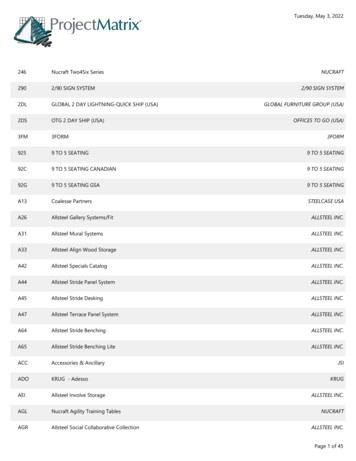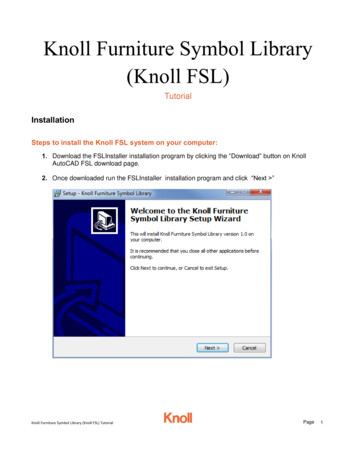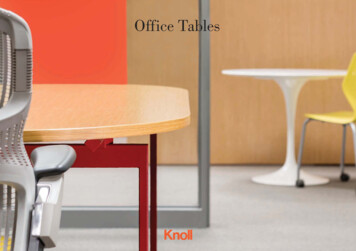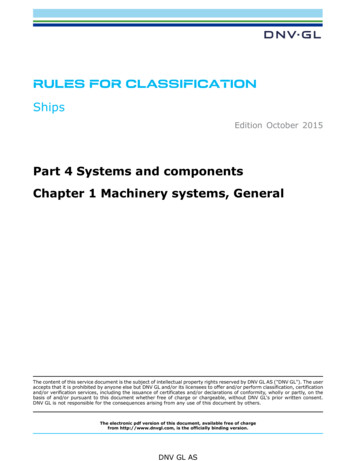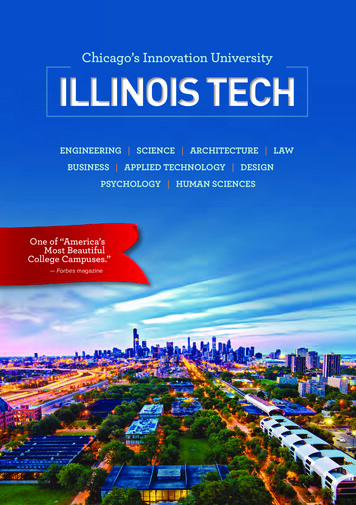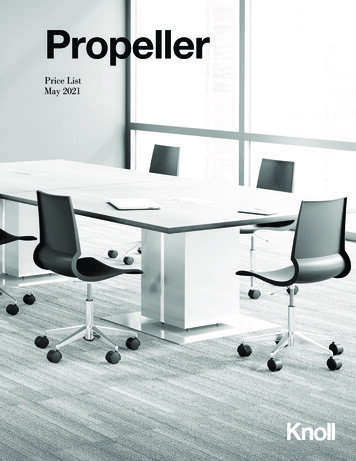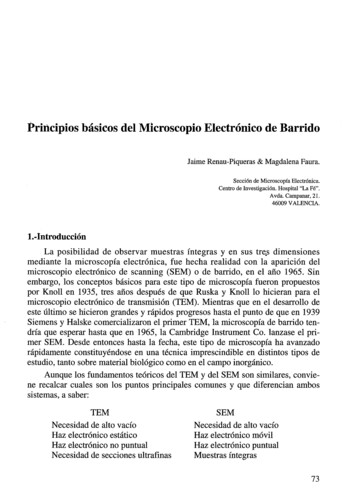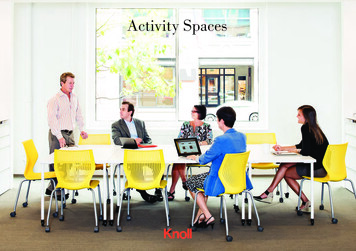
Transcription
Activity Spaces
Every place is a work place.Driven by the pursuit of innovation and efficiency, enabled by technology and expected by a new generation, theoffice has become more collaborative. Work takes place anywhere and everywhere.Ubiquitous technology enables distributed work outside the primary workspace, whether in a meeting room, café,offsite or even outdoors. With people spending on average half of their working hours away from their individualworkspace, organizations are increasing the amount and variety of unassigned activity spaces made availableto everyone for both planned and spontaneous interaction. Activity spaces create visual interest and provideopportunity for an organization to express its brand and culture. Weaving them throughout the floorplan allowspeople to shape their work experience throughout the day to suit their needs and desires.Facing, top row left to right: Pensi table and Toledo chair; Jehs Laub lounge chair and KnollExtra Power Cube. Center row: k. lounge three seatbench and stool, Toboggan pull up table and Anchor locker; Platner lounge chair, Womb chair, Florence Knoll sofa and low table, Bertoia barstool. Bottom row: Antenna Simple table with MultiGeneration by Knoll stacking chair; Antenna Workspaces mobile desk, Generation by Knoll work chair, Interpole storage, screens and display, Antenna Y-base track shape table and MultiGeneration hybrid chair.Cover: Antenna Simple table with MultiGeneration stacking chairThe workplace has becomemore socialKnoll research shows that despite the factthat people can work almost anywhere, theychoose to come to the office to connect faceto-face with coworkers and engage in bothplanned and serendipitous collaboration.A more social and interconnected office is astrategic tool for attracting and retainingthe best talent.
A variety of spaces for a variety of workOffice planning has evolved to integrate more collaborative workstyles both in primary workspaces and incomplementary activity spaces. Activity spaces are “go to” spaces accessible to everyone for everything fromfocused, individual and small group work to large community gatherings. While there is a spectrum of needs—from casual to formal, impromptu to planned, open to enclosed—research confirms the importance of distinctchoices for each type of interaction.Knoll offers numerous solutions for appropriately scaled activity spaces, offering refuge for one or two, enclavefor three or four and team meeting spaces for four to eight. Larger assembly spaces support training andconference activity; and community spaces enable spontaneous and social interaction.Primary workspaces are often assigned to individuals and optimized for focus, shared or team work. Activity spaces are available toindividuals and groups for focus, shared or team work, assembly and social, community activities.2 Knoll
Q Primary WorkspacesQ Refuge (1–2) focusQ Enclave (3–4) shareQ Team Meeting (4-8) teamQ Assembly (10 ) training,conferenceQ Community (unlimited) socialActivity Spaces 3
Refuge“Get away” space for 1–2 peopleRefuge is a small space (about 50 sq ft) that enablesfocused or confidential work by one or two people.A refuge may be an enclosed room with a video display,wall mounted whiteboard surface and adaptable furniture.A refuge may also be an open area with furnitureboundaries or enough space separation for a senseof privacy.One of the most importantelements of successfulactivity spaces is privacy,which may be providedby walls and a door, bystorage or furniture screens,by space separation or evenby a set of headphones.Clockwise, from left:D’Urso swivel chair andlow table with Interpoledisplay; Womb chair andottoman with FilzFeltPig floor mat; AntennaWorkspaces desk withSapper monitor armand ReGeneration byKnoll work chair;MultiGeneration stackingchair and Propeller halfround table with Sappermonitor arm4 Knoll
Activity Spaces 5
Enclave“Get together” spaces for groups of 3–4 peopleEnclave spaces are small open or enclosed spaces (about100 sq ft) available for collaborative seclusion by a group ofthree or four people. Enclaves are usually equipped with adesk height or lower table, whiteboards and a video display.Enclaves are most successful when they combine readyaccess to technology with furnishings that provide a senseof boundary for shared work.6 KnollKnoll research confirms thattechnology—connectivity,display and adaptability—isthe most important attraction ofactivity spaces that work.Clockwise, from left: k. loungeinside radius curved bench withback and stools, DividendsHorizon X base table withround top, Interpole screenand Toboggan pull up table;Antenna Workspaces mediaenclave with end panel andSapper monitor arm andMultiGeneration hybrid chairs;ReGeneration work chair, ReffProfiles height adjustablesliding table with soft rectangletop and credenza with cushion,wall mount Sapper monitorarm; Sprite stacking chairand Dividends Horizon X-basetable with round top; Pfisterlounge chair and Saarinencoffee and side table
Activity Spaces 7
Team Meeting“Breakout” work areas for 4–8 peopleTeam meeting spaces allow the whole team to come tothe table. Typically medium-size work rooms for four toeight people, team meeting spaces may be in the openplan or fully enclosed, with a larger table or clusteredtables, mobile and wall mounted whiteboards and flexibleseating options. Lounge and standing height tables as analternative to desk-height tables can lend variety to theteam experience, as well.The most productive team meeting spaces include multipledisplay surfaces, convenient access to power, a sharedscreen and substantial enclosure to permit undisturbedcollaboration.8 KnollProximity to the primarywork area is critical to thesuccess of team meetingand other activity spaces.Clockwise, from left:Reff Profiles credenza,table with 4x4 legs andbookcase, Moment sidechair and Scribe mobilemarkerboard; DividendsHorizon conference tableand markerboard tile-tofloor panels with Generation work chairs; Interpolescreen, Architecture &Associés sofa and loungechair, KnollExtra PowerCube, Risom lounge chairand stool
Activity Spaces 9
Assembly“Planned interaction” for groups of 10 or moreAssembly spaces are dedicated areas for plannedinteractions and collaborative work. Usually large andenclosed group spaces (400 sq ft), assembly areasare equipped with multiple display surfaces (tackable,whiteboard and video), credenzas for storage and tablesfor refreshments.Conference rooms, sized for groups of ten or more,are typically formal meeting spaces for presentations.Furnishings include a very large, fixed table with power,data and communications.Training rooms—flexible spaces for multiple activities fromeducation to informal presentations—typically includefreely reconfigurable tables and agile chairs.Lecture spaces, whether enclosed or open, are multi-usespaces equipped with flexible furnishings, accommodatinglarge group presentations as well as social events.10 KnollSuccessful activity spacesare scaled appropriately forthe task or activity.Assembly spaces are sizedfor large groups, but arenot well-suited to smallermeetings.Clockwise, from left: MultiGeneration stacking chair;Propeller conference tableand credenza with Life chair, Scribe mobilemarkerboard, Propellertraining table andReGeneration work chair;Propeller training tableand credenza; Generation byKnoll work chair and LSMconference table
Activity Spaces 11
Community“Unplanned interaction” areas open to allCommunity areas encourage casual, personal connectionsand participation with the broader organizational culture.Commons and cafés are large, multipurpose spaces forsocial events or unplanned interactions. And on a smallerscale, ad hoc spaces such as informal seating areas withsmall tables, lounge furniture groupings and standingheight counters with stools welcome a similar sense ofspontaneous, flexible use.Access to wireless networks and food and drink drawpeople into community spaces, along with open sight linesand access to natural light.12 KnollA casual feel attracts usersto community spaces andother activity spaces.Clockwise, from left:MultiGeneration stackingchair with DividendsHorizon X base tablewith round and roundedsquare tops; Anchor locker,k. lounge and Tobogganbench; Reff Profilesstanding height L-legtable, Gigi barstool; 1966Dining table and armlesschair, Olivares Aluminumcounter-height chair,Interpole display; AntennaWorkspaces table, Spritechair, Stromborg table,Spark chair
Activity Spaces 13
Activity SpacesActivity spaces are “go to” spaces accessible to everyone for everything from focused, individual and small group work, to large community gatherings. Knoll offersnumerous solutions for appropriately scaled activity spaces, offering refuge for one or two, enclaves for three or four, team meeting spaces for four to eight people, andlarger assembly and community spaces. All improve workplace efficiency and productivity, encourage collaboration and provide organizations the opportunity to expresstheir culture and brand.Today’s office contains individual primaryworkspaces and non-assigned activity spacesthat are held in common and occupied as needed.Together they create a total work environmentthat supports both individual work and groupinteractions, offering employees choice and controlover their work setting.knoll.com/activityspacesKnoll research has shown that technology,proximity and privacy are the most importantattributes that draw people to activity spaces,followed by appropriate size and casual feel.The mix of these characteristics is critical tosuccessful collaborative spaces.Printed in Canada. B-ACT15 2015 Knoll, Inc. All rights reserved.
bench and stool, Toboggan pull up table and Anchor locker; Platner lounge chair, Womb chair, Florence Knoll sofa and low table, Bertoia bar- . Propeller training table and credenza; Generation by Knoll work chair and LSM conference table. Activity Spaces 11. 12 Knoll Community
